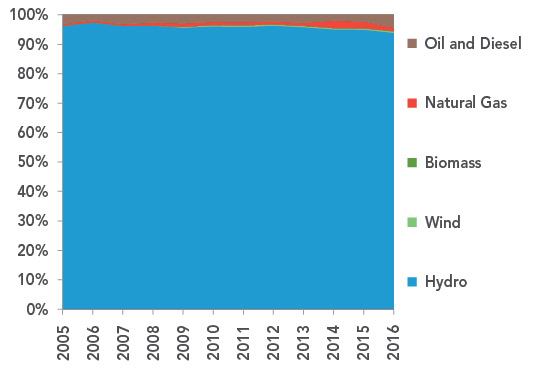ARCHIVED – Canada’s Renewable Power Landscape 2017 – Energy Market Analysis
This page has been archived on the Web
Information identified as archived is provided for reference, research or recordkeeping purposes. It is not subject to the Government of Canada Web Standards and has not been altered or updated since it was archived. Please contact us to request a format other than those available.

Newfoundland and Labrador
Newfoundland and Labrador generated 94.3% of its electricity from renewable sources, almost entirely from hydro. The remaining generation was mainly from oil, diesel, and natural gas.
FIGURE 23 Electricity Generation by Source in Newfoundland and Labrador

Description
This graph shows the composition of Newfoundland and Labrador’s electricity generation between 2005 and 2016. On average, hydro accounted for 95.8% of generation. Wind and biomass generated less than 1% combined. Natural gas averaged 1.2%. Oil and diesel averaged 2.7% of generation.
TABLE 10 Electric Capacity and Generation in Newfoundland and Labrador
| Capacity in MW and % | Generation in GW.h and % | |||||
|---|---|---|---|---|---|---|
| 2005 | 2015 | 2016 | 2005 | 2015 | 2016 | |
| Oil and Diesel | 784 | 737 | 737 | 1 304 | 974 | 1 805 |
| 10.2% | 9.6% | 9.6% | 3.1% | 2.3% | 4.3% | |
| Natural Gas | 103 | 103 | 103 | 269 | 922 | 506 |
| 1.3% | 1.3% | 1.3% | 0.6% | 2.2% | 1.2% | |
| Biomass | 15 | 15 | 15 | 0 | 0 | 70 |
| 0.2% | 0.2% | 0.2% | 0.0% | 0.0% | 0.2% | |
| Wind | 0 | 54 | 54 | 0 | 189 | 190 |
| 0.0% | 0.7% | 0.7% | 0.0% | 0.5% | 0.5% | |
| Hydro | 6 791 | 6 794 | 6 794 | 40 498 | 39 687 | 39 483 |
| 88.3% | 88.2% | 88.2% | 96.3% | 95.0% | 93.9% | |
| All renewable sources | 6 791 | 6 848 | 6 848 | 40 498 | 39 876 | 39 673 |
| 88.3% | 88.9% | 88.9% | 96.3% | 95.5% | 94.3% | |
| All sources | 7 692 | 7 703 | 7 703 | 42 071 | 42 772 | 42 053 |
Generation Trends
Newfoundland and Labrador generated 93.9% of its electricity from hydro in 2016. The Churchill Falls Generating Station in Labrador is the second largest hydro plant in Canada, with an installed capacity of 5 428 MW, and annual generation of about 34 000 GW.h. Under an agreement with Hydro-Québec, a significant portion of generation at the facility is exported to Quebec. Wind and biomass account for a small share of generation, at only 0.7% combined in 2016.
Hydro generation in Newfoundland and Labrador is supplemented with diesel generation at the 500 MW Holyrood Thermal Generating Station, among other facilities. Natural gas is used for electricity generation on offshore oil drilling rigs, and accounts for an estimated 1.2% of the province’s generation.
Capacity Changes in 2016
Newfoundland and Labrador’s capacity in 2016 was the same as in 2015.
More Information
Canada’s Renewable Power Landscape 2016 – Energy Market Analysis provides additional information on renewable power in Newfoundland and Labrador.
Residential Bills and Greenhouse Gas Generation Intensity
Newfoundland and Labrador’s largest city, St. John’s, has a residential electricity bill of $120 for 1 000 kW.h which is slightly lower than the Canadian mean of $129 per 1 000 kW.h. Newfoundland and Labrador’s GHG generation intensity is much lower than most of Canada, emitting 32 grams of GHGs per kW.h compared to the Canadian mean of 140 g GHG/kW.h.
FIGURE 24

Source and Description
Source:
Hydro-Québec, National Inventory Report
Description:
Two dials indicate the monthly residential electricity bill for 1 000 kW.h and the GHG generation intensity in grams of GHG per kW.h. Newfoundland and Labrador’s largest city, St. John’s, has a residential electricity bill of $120 for 1 000 kW.h which is slightly lower than the Canadian mean of $129 per 1 000 kW.h. Newfoundland and Labrador’s GHG generation intensity is much lower than most of Canada, emitting 32 grams of GHGs per kW.h compared to the Canadian mean of 140 g GHG/kW.h.
- Date modified:
